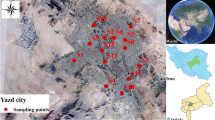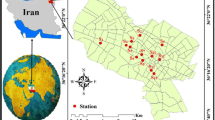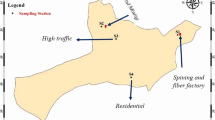Abstract
Asbestos is a naturally occurring fibrous silicate that has been widely used as electrical insulator and heat-resistant material in buildings, yet inhalation of asbestos fibers can lead to serious lung diseases such as asbestosis and cancer. Practically no research has been conducted on the size distribution and morphological characteristics of airborne asbestos, and airborne asbestos concentrations in South Korea are unknown. Here we studied type, concentration, size, morphology and composition of asbestos fibers in the ambient air of several regions in South Korea. Asbestos concentrations were analyzed in 7 urban areas, 7 rural areas including agricultural and fishing areas, 17 mines and their surrounding areas, 7 residential areas constructed with asbestos-containing stones near rivers, 2 baseball fields and 2 background sites. Results show that the highest air asbestos concentrations were 0.00161 for residential areas and 0.00122 for baseball fields according to phase-contrast microscopy, and 0.00057 for asbestos mines and 0.00055 for baseball fields, according to transmission electron microscopy. Asbestos types included chrysotile, tremolite, and actinolite. Chrysotile fibers measured 5.24–35.5 µm in length with aspect ratios of 12.6–202.6; tremolite fibers measured 6.07–40.2 µm in length with aspect ratios of 5.7–81.2; and actinolite fibers measured 5.01–28.5 µm in length with aspect ratios of 3.2–108.9. Chrysotile was distributed in bundles or single fibers, whereas tremolite and actinolite exhibited fibrous, acicular, and cleavage forms.




Similar content being viewed by others
References
Anastasiadou K, Gidarakos E (2007) Toxicity evaluation for the broad area of the asbestos mine of northern Greece. J Hazard Mater 139:9–18. https://doi.org/10.1016/j.jhazmat.2006.06.031
Axten CW, Foster D (2008) Analysis of airborne and waterborne particles around a taconite ore processing facility. Regul Toxicol Pharmacol 52:S66–S72. https://doi.org/10.1016/j.yrtph.2007.11.010
Bayram M, Bakan ND (2014) Environmental exposure to asbestos: from geology to mesothelioma. Curr Opin Pulm Med 20:301–307. https://doi.org/10.1097/mcp.0000000000000053
Brião GDV, de Andrade JR, da Silva MGC, Vieira MGA (2020) Removal of toxic metals from water using chitosan-based magnetic adsorbents. a review. Environ Chem Lett 18:1145–1168. https://doi.org/10.1007/s10311-020-01003-y
Buczaj A, Brzana W, Tarasinska J, Buczaj M, Choina P (2014) Study on the concentration of airbone respirable asbestos fibres in rural areas of the Lublin region in south-east Poland. Ann Agric Environ Med: AAEM 2:639–643. https://doi.org/10.5604/12321966.1120617
Campopiano A, Casciardi S, Fioravanti F, Ramires D (2004) Airborne asbestos levels in school buildings in Italy. J Occup Environ Hyg 1:256–261. https://doi.org/10.1080/15459620490433771
Chang HY, Chen CR, Wang JD (1999) Risk assessment of lung cancer and mesothelioma in people living near asbestos-related factories in Taiwan. Arch Environ Health 54:194–201. https://doi.org/10.1080/00039899909602259
Chesson J, Hatfield J, Schultz B, Dutrow E, Blake J (1990) Airborne asbestos in public buildings. Environ Res 51:100–107. https://doi.org/10.1016/s0013-9351(05)80186-0
Chiappino G, Todaro A, Blanchard O (1993) Atmospheric asbestos pollution in the urban environment: Rome, Orbassano and a control locality (II). Med Lav 81:187–192
Choi Y, Lim S, Paek D (2013) Trades of dangers: a study of asbestos industry transfer cases in Asia. Am J Ind Med 56:335–346. https://doi.org/10.1002/ajim.22144
Corn M (1994) Airborne concentrations of asbestos in non-occupational environments. Ann Occup Hyg 38(495–502):410. https://doi.org/10.1093/annhyg/38.4.495
Damiani F, Paglietti F, Malinconico S (2006) Airborne pollution at biancavilla (Catania, Sicily, Italy) – national interest site – before and after remediation: areal distribution of asbestos-like particulate matter. In: Atti del Convegno ‘‘European Conference on Asbestos Risks and Management’’, Rome, 4–6 Dicembre 2006, 114–119.
Das PK, Das BP, Dash P (2020) Chromite mining pollution, environmental impact, toxicity and phytoremediation: a review. Environ Chem Lett. https://doi.org/10.1007/s10311-020-01102-w
de Gennaro G, Dambruoso PR, Loiotile AD, Di Gilio A, Giungato P, Tutino M, Marzocca A, Mazzone A, Palmisani J, Porcelli F (2014) Indoor air quality in schools. Environ Chem Lett 12:467-482. https://doi.org/https://doi.org/10.1007/s10311-014-0470-6
Environmental Protection Agency (1982) Interim Method for the Determination of Asbestos in Bulk Insulation Samples
Environmental Protection Agency (1987) Asbestos-containing materials in schools: final rule and notice. 40 CFR 763, appendix A to subpart E
Environmental Protection Agency (2005) El Dorado hills naturally occurring asbestos multimedia exposure assessment: preliminary assessment and site inspection report, El Dorado Hills, CA, Environmental Protection Agency
Environmental Protection Agency (2011) Risk evaluation for activity-based sampling results. Suman Mountain Asbestos Site, Whatcom county, Washington
Gidarakos E, Anastasiadou E, Koumantakis E, Nikolaos S (2008) Investigative studies for the use of an inactive asbestos mine as a disposal site for asbestos wastes. J Hazard Mater 153:955–965. https://doi.org/10.1016/j.jhazmat.2007.09.060
Hansen J, de Klerk NH, Eccles JL, Musk AW, Hobbs MS (1993) Malignant mesothelioma after environmental exposure to blue asbestos. International Journal of Cancer. J Int du Cancer 54:578–581. https://doi.org/10.1002/ijc.2910540410
Hendrickx M (2009) Naturally occurring asbestos in eastern Australia: a review of geological occurrence, disturbance and mesothelioma risk. Environ Geol 57:909–926. https://doi.org/10.1007/s00254-008-1370-5
Howitt DG, Hatfield J, Fishler G (1993) The difficulties with low-level asbestos exposure assessments in public, commercial, and industrial buildings. Am Ind Hyg Assoc J 54:267–271. https://doi.org/10.1080/15298669391354658
International Standard Organization (1995) Ambient Air - Determination of Asbestos Fibers - Direct-Transfer Transmission Electron Microscopy Method.
Jaffrey TSAM (1990) Levels of airborne man-made mineral fibres in U.K. dwellings. I—Fibre levels during and after installation of insulation. Atmosp Environ Part A Gen Topics 24:133–141. https://doi.org/10.1016/0960-1686(90)90448-V
Jung SH, Kim HR, Koh SB, Yong SJ, Chung MJ, Lee CH, Han J, Eom MS, Oh SS (2012) A decade of malignant mesothelioma surveillance in Korea. Am J Ind Med 55:869–875. https://doi.org/10.1002/ajim.22065
Jung HS, Cha JS, Kim S, Lee W, Lim HJ, Kim H (2015) Evaluating the efficiency of an asbestos stabilizer on ceiling tiles and the characteristics of the released asbestos fibers. J Hazard Mater 300:378–386. https://doi.org/10.1016/j.jhazmat.2015.07.021
Jung HS, Park EK, Cha JS, Lee JW, Lee JC, Jang J, Kim S, Oak C, Yates DH, Kim H (2020) Characteristics of asbestos fibers in lung tissue from occupational and environmental asbestos exposure of lung cancer patients in Busan. Korea Sci Rep 10:20359. https://doi.org/10.1038/s41598-020-77291-9
Jung HS, Jang J, Park EK, Cho Y, Lee JC, Kim H (2021) Changes in concentrations and characteristics of asbestos fibers dispersed from corrugated asbestos cement sheets due to stabilizer treatment. J Environ Manage 285:112110. https://doi.org/10.1016/j.jenvman.2021.112110
Kakooei H, Yunesian M, Marioryad H, Azam K (2009) Assessment of airborne asbestos fiber concentrations in urban area of Tehran, Iran. Air Quality, Atmosphere, and Health 2: 39–45.https://doi.org/10.1007/s11869-009-0032-4
Kakooei H, Meshkani M, Azam K (2013) Ambient monitoring of airborne asbestos in non-occupational environments in Tehran, Iran. Atmosp Environ 81:671–675. https://doi.org/10.1016/j.atmosenv.2013.09.022
Kangur M (2007) Occupational exposure to asbestos during renovation of oil-shale fuelled power plants in Estonia. Int J Occup Saf Ergon: JOSE 13:341–346. https://doi.org/10.1080/10803548.2007.11076733
Kim HR (2009) Overview of asbestos issues in Korea. J Korean Med Sci 24:363–367. https://doi.org/10.3346/jkms.2009.24.3.363
Korea Ministry of the Environment (2007) Ministry of the Environment. Asbestos test method of Atmospheric Environment
Korea Ministry of the Environment (2009) Atmospheric concentrations of asbestos appears highly surrounding workplace of the demolition and removal of asbestos-containing buildings
Korea Ministry of the Environment (2010a) Asbestos detected in the atmosphere around the workplace of demolition and removal
Korea Ministry of the Environment (2010b) Description related to the asbestos-containing landscape stone
Korea Ministry of the Environment (2010c) Determination of the Number Concentration of Airborne Asbestos Fibers and Other Fibers in Indoor by Phase Contrast Microscope
Korea Ministry of the Environment (2011a) Results of the Survey of Asbestos in the Ballpark, Health Impact is Negligible. Reconstruction Field
Korea Ministry of the Environment (2011b) Asbestos Injury Relief Act
Korea Ministry of the Environment (2012) Check the asbestos contamination in the soil around the waste asbestos mines
Korea Ministry of the Environment (2013) Check the asbestos contamination in the five asbestos mines
Korea Ministry of the Environment (2014) Asbestos-contaminated soil detected in three asbestos mine in South Chungcheong Province
Korea Ministry of the Environment (2015) A description of concerns caused by exposure to asbestos in the reconstruction field
Koumantakis E, Kalliopi A, Dimitrios K, Gidarakos E (2009) Asbestos pollution in an inactive mine: determination of asbestos fibers in the deposit tailings and water. J Hazard Mater 167:1080–1088. https://doi.org/10.1016/j.jhazmat.2009.01.102
Kwon J, Seo HK, Kim KB, Chung EK (2013) Occupational exposure to airborne asbestos fibers in serpentine quarries and a steel mill. Journal of Korean Society of Occupational and Environmental Hygiene 23: 35–40. http://www.jksoeh.org/opensource/pdfjs/web/pdf_viewer.htm?code=J02301005
Lajoie P, Drouin L, Dufresne A, Le´vesque B, Perrault G, Prud’homme H, Roberge L, Simard R, Turcot A, Tardif J.M (2003) Asbestos fibres in indoor and outdoor air: the situation in Quebec, Institut National de Sante´ Publique du Que´bec
Lee RJ, Van Orden DR (2008) Airborne asbestos in buildings. Regul Toxicol Pharmacol: RTP 50:218–225. https://doi.org/10.1016/j.yrtph.2007.10.005
Lee RJ, Strohmeier BR, Bunker KL, Van Orden DR (2008) Naturally occurring asbestos: a recurring public policy challenge. J Hazard Mater 153:1–21. https://doi.org/10.1016/j.jhazmat.2007.11.079
Lee J, Kim D, Choi S, Kim H (2015) Asbestos exposure and risk assessment by ABS (activity based sampling) for former asbestos mining areas in Korea. J Korean Soc Occup Environ Hygiene 25:72–81. https://doi.org/10.15269/JKSOEH.2015.25.1.72
Lim HS, Kim JY, Sakai K, Hisanaga N (2004) Airborne asbestos and non-asbestos fiber concentrations in non-occupational environments in Korea. Ind Health 42:171–178. https://doi.org/10.2486/indhealth.42.171
Lippmann M (1988) Asbestos exposure indices. Environ Res 46:86–106. https://doi.org/10.1016/s0013-9351(88)80061-6
Lippmann M (2014) Toxicological and epidemiological studies on effects of airborne fibers: coherence and public [corrected] health implications. Crit Rev Toxicol 44:643–695
Loomis D, Dement J, Richardson D, Wolf S (2010) Asbestos fibre dimensions and lung cancer mortality among workers exposed to chrysotile. Occup Environ Med 67:580–584
Markowitz S (2015) Asbestos-related lung cancer and malignant mesothelioma of the pleura: selected current issues. Semin Respir Crit Care Med 36:334–346. https://doi.org/10.1055/s-0035-1549449
Meeker GP, Bern AM, Brownfield IK, Lowers HA, Sutley SJ, Hoefen TM, Vance JS (2003) The composition and morphology of amphiboles from the Rainy Creek complex, near Libby, Montana. Am Miner 88:1955–1969. https://doi.org/10.2138/am-2003-11-1239
Mensi C, Riboldi L, De Matteis S, Bertazzi PA, Consonni D (2015) Impact of an asbestos cement factory on mesothelioma incidence: global assessment of effects of occupational, familial, and environmental exposure. Environ Int 74:191–199. https://doi.org/10.1016/j.envint.2014.10.016
Mukherjee A, Agrawal M (2017) World air particulate matter: sources, distribution and health effects. Environ Chem Lett 15:283–309. https://doi.org/10.1007/s10311-017-0611-9
Mukherjee A, Agrawal M (2018) Air pollutant levels are 12 times higher than guidelines in Varanasi, India. Sour Transf Environ Chem Lett 16:1009–1016. https://doi.org/10.1007/s10311-018-0706-y
Park J, Hisanaga N, Kim Y (2009) Transfer of occupational health problems from a developed to a developing country: lessons from the Japan-South Korea experience. Am J Ind Med 52:625–632. https://doi.org/10.1002/ajim.20723
Pastuszka JS (2009) Emission of airborne fibers from mechanically impacted asbestos-cement sheets and concentration of fibrous aerosol in the home environment in Upper Silesia, Poland. J Hazard Mater 162:1171–1177. https://doi.org/10.1016/j.jhazmat.2008.06.045
Reid A, Berry G, de Klerk N, Hansen J, Heyworth J, Ambrosini G, Fritschi L, Olsen N, Merler E, Musk AW (2007) Age and sex differences in malignant mesothelioma after residential exposure to blue asbestos (crocidolite). Chest 131:376–382. https://doi.org/10.1378/chest.06-1690
Ryan PH, LeMasters GK, Burkle J, Lockey JE, Black B, Rice C (2015) Childhood exposure to Libby amphibole during outdoor activities. J Eposure Sci Environ Epidemiol 25:4–11. https://doi.org/10.1038/jes.2013.26
Sakai K, Hisanaga N, Kohyama N, Shibata E, Takeuchi Y (2001) Airborne fiber concentration and size distribution of mineral fibers in area with serpentinite outcrops in Aichi prefecture, Japan. Ind Health 39:132–140. https://doi.org/10.2486/indhealth.39.132
Shin J-H, Lee S-C, Chung S-N, Oh S-R, Kim N-J, Hwang S-Y, Kim J-H, Nam E-J, Eom S-W, Chae Y-Z (2011) Asbestos investigation of an inactive mine in Chungbuk. J Korean Soc Environ Anal 14: 110–119
Song S, Hwang JH, Hwang BG, Kim H (2008) Occurrence types and mineralogical characteristics of asbestos for the Kwangcheon area, Chungnam. J Korean Soc Occup Environ Hygiene 18: 271–281
Spurny KR (1989) On the release of asbestos fibers from weathered and corroded asbestos cement products. Environ Res 48:100–116. https://doi.org/10.1016/s0013-9351(89)80089-1
Stanton MF, Layard M, Tegeris A, Miller E, May M, Morgan E, Smith A (1981) Relation of particle dimension to carcinogenicity in amphibole asbestoses and other fibrous minerals. J Natl Cancer Inst 67:965–975. https://doi.org/10.1093/jnci/67.5.965
Stayner L, Kuempel E, Gilbert S, Hein M, Dement J (2008) An epidemiological study of the role of chrysotile asbestos fibre dimensions in determining respiratory disease risk in exposed workers. Occup Environ Med 65:613–619. https://doi.org/10.1136/oem.2007.035584
Tadas P, Dainius M, Edvinas K, Linas K, Maksim K, Axel Z (2011) Comparative characterization of particle emissions from asbestos and non-asbestos cement roof slates. Build Environ 46:2295–2302. https://doi.org/10.1016/j.buildenv.2011.05.010
The European parliament and the council of the European Union (2009) Directive 2009/148/EC of the European Parliament and of the Council of 30 November 2009 on the Protection of Workers from the Risks Related to Exposure to Asbestos at Work. Official Journal of the European Union 330: 28–36. https://eur-lex.europa.eu/eli/dir/2009/148/oj
Whysner J, Covello VT, Kuschner M, Rifkind AB, Rozman MK, Trichopoulos D, Williams GM (1994) Asbestos in the air of public buildings: a public health risk? Prev Med 23:119–125. https://doi.org/10.1006/pmed.1994.1017
World Health Organization (1989) Occupational exposure limit for asbestos, World Health Organization
Yu S.W, Kim HW (1996) Characterization of asbestos content in friable sprayed on surface material and airborne asbestos concentrations in buildings by TEM. J Korean Soc Occup Environ Hygiene 6: 165–175
Acknowledgements
This work was supported by the National Institute of Environment Research (NIER), funded by the Ministry of Environment of Korea (MOE) of the Republic of Korea (grant number NIER RP2011-1355).
Author information
Authors and Affiliations
Contributions
Hyun-Sung Jung, Hyunwook Kim were involved in conceptualization and methodology; Hyun-Sung Jung, Jinyoung Jang, Yangseok Cho contributed to formal analysis and investigation; Hyun-Sung Jung was involved in writing – original draft preparation; Hyun-Sung Jung, Jinyoung Jang, Jong-Chun Lee, Hyunwook Kim contributed to writing—review and editing; Jong-Chun Lee was involved in funding acquisition; Jong-Chun Lee, Hyunwook Kim contributed to supervision.
Corresponding author
Ethics declarations
Competing interest
The authors declare that they have no known competing financial interests or personal relationships that could have appeared to influence the work reported in this paper.
Additional information
Publisher's Note
Springer Nature remains neutral with regard to jurisdictional claims in published maps and institutional affiliations.
Supplementary Information
Below is the link to the electronic supplementary material.
Rights and permissions
About this article
Cite this article
Jung, HS., Jang, J., Cho, Y. et al. Asbestos in the ambient air from rural, urban, residential, baseball and mining areas in South Korea. Environ Chem Lett 19, 3487–3495 (2021). https://doi.org/10.1007/s10311-021-01226-7
Received:
Accepted:
Published:
Issue Date:
DOI: https://doi.org/10.1007/s10311-021-01226-7




